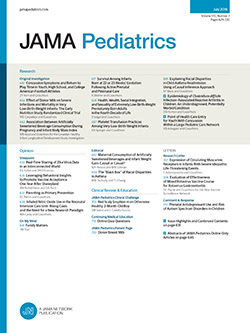Digital Health Interventions in Pediatric Perioperative Care: A Network Meta-Analysis.
IF 18
1区 医学
Q1 PEDIATRICS
引用次数: 0
Abstract
Importance Pediatric surgical patients often face considerable perioperative challenges, including anxiety and pain. Digital health interventions offer promise, but their efficacy remains uncertain. Objective To compare the effects of digital health interventions in pediatric perioperative care. Data Sources PubMed, Embase, Web of Science, CENTRAL, and CINAHL databases were searched up to March 1, 2025. Study Selection Randomized clinical trials (RCTs) involving pediatric patients (aged ≤18 years) undergoing surgery with general anesthesia, where digital technology was used as a distraction intervention. Data Extraction and Synthesis A frequentist network meta-analysis with random-effects model was used to calculate standardized mean differences (SMDs) or mean differences (MDs) with 95% CIs. Interventions were ranked using P values, risk of bias assessed using the Cochrane risk of bias tool 2, and certainty of evidence rated using the Grading of Recommendations, Assessment, Development, and Evaluations framework. Main Outcomes and Measures Critical outcomes included pediatric preoperative anxiety, postoperative pain, emergence delirium, and induction compliance. Important but noncritical outcomes encompassed parental preoperative anxiety and postoperative satisfaction. Results Of 7734 RCTs screened, 49 were included involving 4535 youth (pooled mean age, 7.42 years; 95% CI, 6.85 to 7.99; 2989 [65.9%] male) with 7 interventions: virtual reality (VR), 2-dimensional (2D) games, 2D videos, interactive robots, midazolam, control (standard care), and enhanced control (eg, booklets). Compared to control, VR (SMD, -1.14; 95% CI, -1.54 to -0.74; moderate certainty), 2D videos (SMD, -1.08; 95% CI, -1.51 to -0.65; moderate certainty), 2D games (SMD, -1.02; 95% CI, -1.54 to -0.49; low certainty), and enhanced control (SMD, -0.83; 95% CI, -1.53 to -0.13; low certainty) reduced preoperative anxiety. VR (SMD, -1.09; 95% CI, -1.58 to -0.59; moderate certainty), 2D games (SMD, -0.87; 95% CI, -1.62 to -0.12; low certainty), and 2D videos (SMD, -0.56; 95% CI, -1.06 to -0.06; moderate certainty) reduced postoperative pain. VR showed the greatest effect on compliance (MD, -0.93; 95% CI, -1.62 to -0.24; moderate certainty). No significant differences compared to control. Conclusions and Relevance This network meta-analysis of RCTs found that VR, 2D videos, and 2D games significantly reduced pediatric perioperative anxiety and pain and improved induction compliance. These findings support the use of digital health interventions in pediatric perioperative care and their broader clinical adoption.儿童围手术期护理的数字健康干预:网络荟萃分析。
儿科外科患者经常面临相当大的围手术期挑战,包括焦虑和疼痛。数字卫生干预提供了希望,但其功效仍不确定。目的比较数字化健康干预在儿童围手术期护理中的效果。检索截止到2025年3月1日的pubmed、Embase、Web of Science、CENTRAL和CINAHL数据库。研究选择随机临床试验(RCTs)涉及接受全麻手术的儿科患者(年龄≤18岁),其中使用数字技术作为分心干预。采用随机效应模型的频率网络元分析计算95% ci的标准化平均差异(SMDs)或平均差异(MDs)。使用P值对干预措施进行排序,使用Cochrane偏倚风险工具2评估偏倚风险,并使用推荐、评估、发展和评估框架分级对证据的确定性进行评级。主要结局和测量关键结局包括儿童术前焦虑、术后疼痛、出现谵妄和诱导依从性。重要但非关键的结果包括父母术前焦虑和术后满意度。结果在筛选的7734项随机对照试验中,纳入49项,涉及4535名青年(合计平均年龄7.42岁,95% CI为6.85 ~ 7.99,男性2989例(65.9%)),采用7种干预措施:虚拟现实(VR)、二维(2D)游戏、2D视频、交互式机器人、咪达唑仑、对照(标准护理)和强化对照(如小册子)。与对照组相比,VR (SMD, -1.14; 95% CI, -1.54至-0.74;中等确定性)、2D视频(SMD, -1.08; 95% CI, -1.51至-0.65;中等确定性)、2D游戏(SMD, -1.02; 95% CI, -1.54至-0.49;低确定性)和强化控制(SMD, -0.83; 95% CI, -1.53至-0.13;低确定性)减少了术前焦虑。VR (SMD, -1.09; 95% CI, -1.58至-0.59;中等确定性)、2D游戏(SMD, -0.87; 95% CI, -1.62至-0.12;低确定性)和2D视频(SMD, -0.56; 95% CI, -1.06至-0.06;中等确定性)减轻了术后疼痛。VR对依从性的影响最大(MD, -0.93; 95% CI, -1.62至-0.24;中等确定性)。与对照组相比无显著差异。结论和相关性这项随机对照试验的网络荟萃分析发现,VR、2D视频和2D游戏显著降低了儿童围手术期的焦虑和疼痛,提高了诱导依从性。这些发现支持在儿科围手术期护理中使用数字健康干预措施及其更广泛的临床应用。
本文章由计算机程序翻译,如有差异,请以英文原文为准。
求助全文
约1分钟内获得全文
求助全文
来源期刊

JAMA Pediatrics
PEDIATRICS-
CiteScore
31.60
自引率
1.90%
发文量
357
期刊介绍:
JAMA Pediatrics, the oldest continuously published pediatric journal in the US since 1911, is an international peer-reviewed publication and a part of the JAMA Network. Published weekly online and in 12 issues annually, it garners over 8.4 million article views and downloads yearly. All research articles become freely accessible online after 12 months without any author fees, and through the WHO's HINARI program, the online version is accessible to institutions in developing countries.
With a focus on advancing the health of infants, children, and adolescents, JAMA Pediatrics serves as a platform for discussing crucial issues and policies in child and adolescent health care. Leveraging the latest technology, it ensures timely access to information for its readers worldwide.
 求助内容:
求助内容: 应助结果提醒方式:
应助结果提醒方式:


